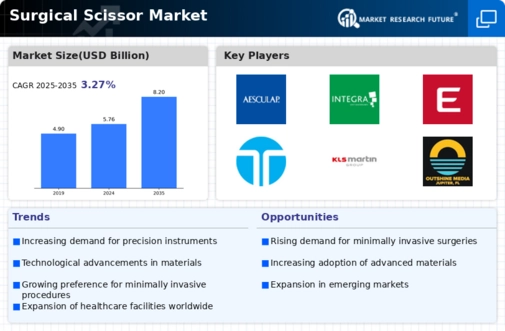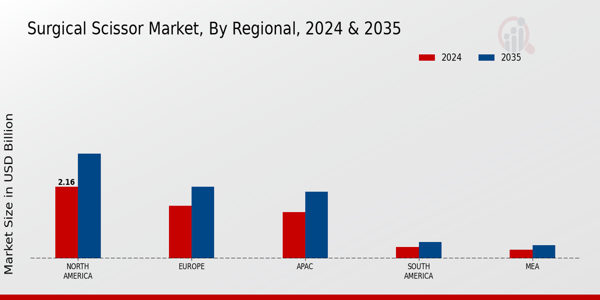Market Growth Projections
The Global Surgical Scissor Market Industry is projected to experience substantial growth over the coming years. With a market value anticipated to reach 5.76 USD Billion in 2024 and further increase to 8.2 USD Billion by 2035, the industry is poised for a promising trajectory. The compound annual growth rate of 3.26% from 2025 to 2035 indicates a steady expansion, driven by factors such as rising surgical procedures, technological advancements, and increasing healthcare expenditures. This growth reflects the essential role of surgical scissors in modern medical practices, underscoring their importance in enhancing surgical outcomes and patient care.
Expansion of Surgical Specialties
The expansion of surgical specialties significantly impacts the Global Surgical Scissor Market Industry. As new surgical fields emerge and existing ones evolve, the demand for specialized surgical instruments, including scissors, increases. For instance, the rise of minimally invasive surgeries has led to the development of scissors tailored for specific procedures, enhancing precision and reducing recovery times. This diversification within surgical practices necessitates a broader range of surgical tools, thereby driving market growth. The continuous evolution of surgical specialties suggests a sustained demand for innovative surgical scissors, aligning with the overall trajectory of the healthcare industry.
Increasing Healthcare Expenditure
The Global Surgical Scissor Market Industry benefits from rising healthcare expenditures across various regions. Governments and private sectors are investing significantly in healthcare infrastructure, leading to enhanced surgical capabilities. For instance, countries are allocating larger budgets for healthcare services, which includes the procurement of advanced surgical instruments. This trend is particularly evident in emerging economies, where the demand for quality surgical tools is on the rise. As healthcare spending continues to grow, the market for surgical scissors is expected to expand, reflecting the broader investment in healthcare quality and accessibility.
Growing Awareness of Surgical Safety
There is a heightened awareness regarding surgical safety and the importance of using high-quality surgical instruments, including scissors. The Global Surgical Scissor Market Industry is influenced by initiatives aimed at improving patient safety and surgical outcomes. Healthcare organizations are increasingly emphasizing the need for reliable and effective surgical tools to minimize complications during procedures. This focus on safety drives the demand for premium surgical scissors, as hospitals and surgical centers prioritize the procurement of instruments that meet stringent safety standards. Consequently, this trend is likely to bolster market growth as healthcare providers seek to enhance their surgical practices.
Rising Demand for Surgical Procedures
The Global Surgical Scissor Market Industry experiences a notable surge in demand due to the increasing number of surgical procedures performed worldwide. Factors such as an aging population and the prevalence of chronic diseases contribute to this trend. For instance, the World Health Organization indicates that surgical interventions are essential for managing various health conditions. This growing demand is projected to elevate the market value to 5.76 USD Billion in 2024, with expectations of reaching 8.2 USD Billion by 2035. Such growth reflects a compound annual growth rate of 3.26% from 2025 to 2035, highlighting the importance of surgical scissors in modern healthcare.
Technological Advancements in Surgical Instruments
Technological innovations play a pivotal role in shaping the Global Surgical Scissor Market Industry. The introduction of advanced materials and designs enhances the functionality and precision of surgical scissors. For example, the integration of ergonomic designs and lightweight materials improves usability for surgeons, thereby increasing efficiency during procedures. Furthermore, the development of specialized scissors for specific surgical applications, such as laparoscopic surgeries, indicates a trend towards customization in surgical tools. These advancements not only improve surgical outcomes but also contribute to the overall growth of the market, as healthcare facilities increasingly adopt state-of-the-art instruments.


















Leave a Comment